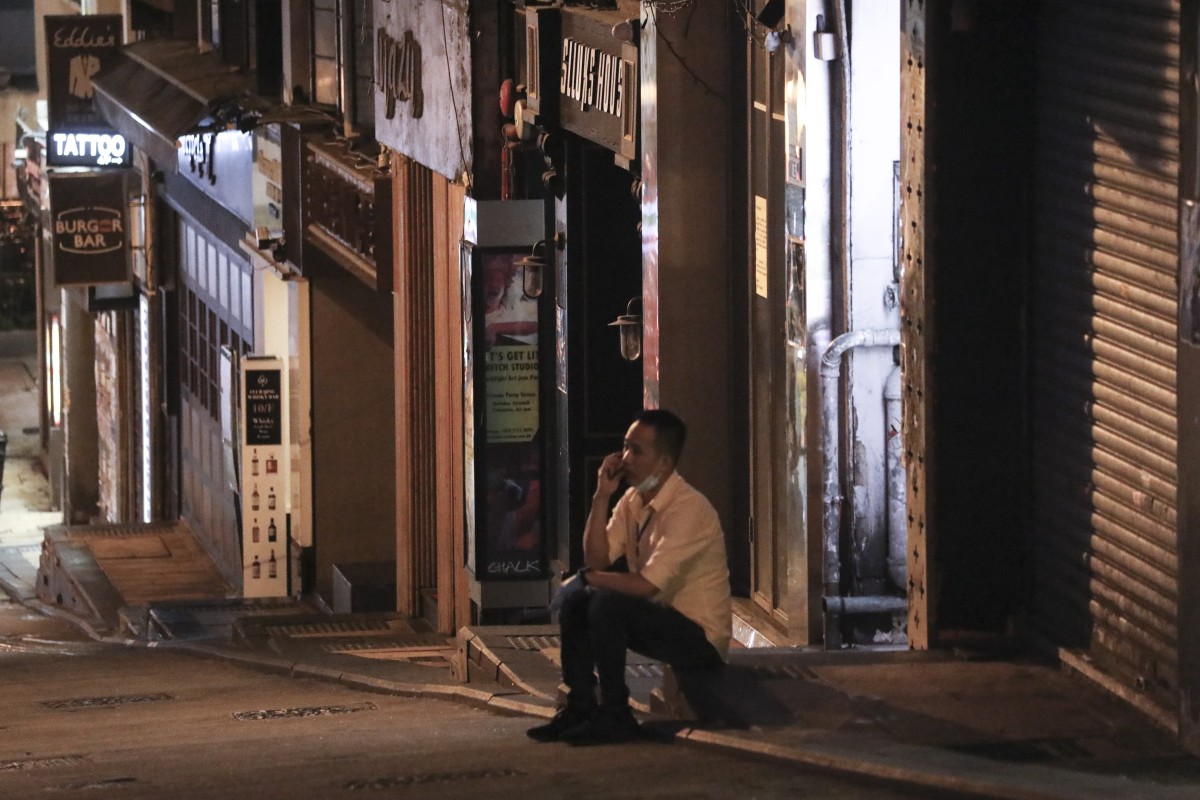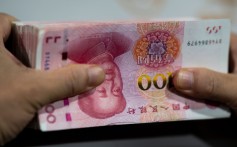The ILO estimates 6.7 per cent of working hours, or 195 million full-time jobs, will be lost worldwide in the second quarter of the year. This is why so many governments, including in Hong Kong, have taken radical steps to support workersOpinion
Outside In by David Dodwell Published: 11 Apr, 2020

A man sits alone in the deserted nightlife district of Lan Kwai Fong
in Hong Kong on April 2. Photo: Dickson Lee
Memories of the pain and harm done by the US-China trade war and six months of street violence across Hong Kong may not have faded, but they have, in the past three months, been overwhelmed by the coronavirus, and the unremitting angst that this invisible enemy has caused in communities worldwide.
So it is not good news that the worst is yet to come, and might not be done with us until well into 2021.
Memories of the pain and harm done by the US-China trade war and six months of street violence across Hong Kong may not have faded, but they have, in the past three months, been overwhelmed by the coronavirus, and the unremitting angst that this invisible enemy has caused in communities worldwide.
So it is not good news that the worst is yet to come, and might not be done with us until well into 2021.
We are only now beginning to sense the scale of the economic harm being inflicted in the fight against the spread of the virus. That is mainly because this harm is still not clearly perceptible and has yet to be fully captured by data. The disastrous domino effect of domestic lockdowns and international self-isolation is now beginning to be seen, but not yet felt.
Two important reports this week have provided us with some sketchy numbers about the future facing us. The first, from the World Trade Organisation, foresees global merchandise trade collapsing this year by between 13 and 32 per cent – in raw numbers, that means a fall of between US$2.4 trillion and US$6 trillion, from US$18.89 trillion in 2019.
Worst impacted will be North America, with exports expected to decline by 17 to 41 per cent, and imports by 14 to 34 per cent. If such forecasts are anywhere near accurate, you can see why Donald Trump is so concerned about deflecting blame ahead of the United States presidential election in November.
The WTO says the crash in services trade, never captured as accurately as merchandise trade, will be even more severe. “These numbers are ugly,” says Roberto Azevedo, WTO director general.
For manufactures, the worst harm will fall on electronics, the automotive and other industries “characterised by complex value chain linkages”. Economies most in harm’s way will be those deeply embedded in long and complex value chains.
Worst impacted will be North America, with exports expected to decline by 17 to 41 per cent, and imports by 14 to 34 per cent. If such forecasts are anywhere near accurate, you can see why Donald Trump is so concerned about deflecting blame ahead of the United States presidential election in November.
The WTO says the crash in services trade, never captured as accurately as merchandise trade, will be even more severe. “These numbers are ugly,” says Roberto Azevedo, WTO director general.
For manufactures, the worst harm will fall on electronics, the automotive and other industries “characterised by complex value chain linkages”. Economies most in harm’s way will be those deeply embedded in long and complex value chains.
These include Mexico, Malaysia and Vietnam, with more than 50 per cent foreign value added in their exports, Singapore (over 40 per cent), South Korea (over 30 per cent) and
China (25 per cent).
The second report, from the International Labour Organisation, provides a sobering glimpse into why so many governments – including our own in Hong Kong – have taken such radical steps to support workers, pre-empt redundancies and avert the thousands of bankruptcies that will almost certainly be upon us soon.
The ILO estimates 6.7 per cent of working hours, or 195 million full-time jobs, will be lost worldwide in the second quarter of this year. Sobering US unemployment data released on Thursday – which show that 17 million Americans have in the past month applied for unemployment benefit for the first time – obviously lends strength to these estimates.
learly, some areas of work have not been affected: teachers, health workers, government employees, police and army officers, and people in power and utility companies will not suffer significantly.
But, for other areas of work, the prognosis is grim: accommodation and food services, real estate, business services, manufacturing, and wholesale and retail trades have been slammed worldwide, with no early recovery expected. These sectors account for about 38 per cent of all jobs worldwide – about 1.25 billion.
Look at Hong Kong, and you see good reasons for local alarm. Our economy is built on exactly those sectors facing the grimmest challenges (the ILO says transport is another such sector). Clearly, moves by Carrie Lam Cheng Yuet-ngor’s administration to
throw meaningful lifelines to large parts of the workforce have come not a moment too soon.
The ILO data also provides a glimpse into the coming collapse in consumption. Working hours are expected to fall by 7.2 per cent in Asia in the coming quarter, and this means that the average household in Hong Kong, with a median income of HK$27,000 a month, would have HK$1,944 less to spend.
Since there are 2.51 million households in Hong Kong, this means spending power in the community might fall by about HK$4.8 billion per month, or HK$14.6 billion per quarter.
Apply the same arithmetic to the US, where there are 129 million households earning a median household income of US$4,900 a month,
(THAT IS DISPROPORTIONATELY HIGH TRY $2500-$3000)
and you find families losing US $329 per month in spending power – amounting to US$42.5 billion for the US as a whole, and US$127.5 billion for the quarter – not a small chunk out of the Congress-approved US$2 trillion rescue payout agreed two weeks ago.
Extend such arithmetic to the entire world, and one quickly sees why so many leading businesses are in a sweat about a protracted recession.
While the hope is that the world economy might quickly recover from this implosion, evidence suggests that recovery will be slow and that, as we emerge, much will have changed forever.
A restructuring of supply chains, with some being shortened, domesticated and made more resilient, seems inevitable. There might be some decoupling between the US and China – though it will be fascinating to see who then couples with the US, and who with China.
Will record global debt trump all other crises in 2020?
30 Dec 2019

Out of the coming recession, government indebtedness is set to rise to record levels across the world, with no clear prospect of how debts will be managed back to sustainable levels. Lockdowns have also brought digital delivery of everything to the heart of many economies, with the imminent arrival of 5G platforms set to put this trend on steroids.
But some parts of our future look less clear. Will international tourism – which accounts for one in 10 jobs worldwide – rebound in answer to airlines’ prayers? Will inequalities that have been exposed by the pandemic be tackled, or continue to be airbrushed?
While lockdowns have brought down carbon emissions (by 60 per cent in Europe), can this be sustained, or will global warming accelerate as recovery begins?
Perhaps most important of all, can we summon the statesmanship to work together across the world to bring the pandemic under control, and manage an economic recovery? So far, the odds are poor. In the US, Trump seems set on blaming all around him.
And the European Union looks perilously divided. It is a cliché to say opportunities arise out of every crisis, but at this particular bleak moment, those opportunities seem tough to find. For the good of all of us, we need to find them fast.
David Dodwell researches and writes about global, regional and Hong Kong challenges from a Hong Kong point of view

David Dodwell is the executive director of the Hong Kong-APEC Trade Policy Study Group, a trade policy think tank.
No comments:
Post a Comment